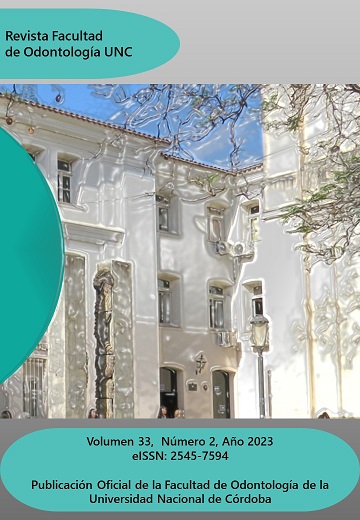Cone beam computed tomography evaluation of pterygoid hamulus
Keywords:
Hamular process; Radiology; Morphology, MorphometryAbstract
Introduction: The hamular process topographically arises from the terminal part of the medial bone lamina and it is a sickle or hook-shaped process located distal and medial to the maxillary tuberosity. Its morphology is very varied as well as its size and its terminal portion can be thin or bulbous. In the literature, the average length and width are 5.3 mm and 1.6 mm, respectively. It commonly has a lateral deviation in the coronal plane and a posterior deviation in the sagittal plane. The present study aimed to analyze the morphology and morphometry of hamular processes in Cone Beam Computed Tomography (CBCT) slices. Cone-beam computed tomography slices of 200 patients (100 male and 100 female) were analyzed. A field of view of 80 mm by 80 mm and an isotropic voxel size of 200 µm. Images obtained were viewed and analyzed with Romexis software 4.4.0.R. where Hamular processes measurements were taken. In the different slices, the Hamular processes were observed as cortical bone hyperdense images. They presented an average length of 5.42mm and an average width of 1,80 mm. The deviations of the hamulus laterally outwards in the coronal plane presented an average angle of 32°. In the sagittal slices, hamular processes presented a posterior deviation (85%). In our study, the morphology and size of these bone processes presented similar values to those reported in the literature. Knowledge of the statistically most frequent morphological and morphometric characteristics of hamular processes allows the dental professional to diagnose different pathological alterations, such as their abnormal deviation or their elongation that may be a cause of different disorders such as obstructive sleep apnea or hamular process syndrome.
References
1. Cappuccio HR. Contribución al estudio de la anatomía funcional del hueso esfenoides. Acta odont. 2010; 7 (1): 40 – 48.
2. Gray, Henry. Anatomy of the Human Body. Philadelphia: Lea & Febiger, 1918; Bartleby.com, 2000. www.bartleby.com/107/.
3. Ramírez LM, Ballesteros LE, Sandoval P. Bursitis Hamular y su posible sintomatología craneofacial referida: Reporte de dos casos. Med oral patol oral cir bucal. 2006; 11(4): 329-333.
4. Komarnitki I, T. Skadorwa T, Chloupek A. Radiomorphometric assessment of the pterygoid hamulus as a factor promoting the pterygoid hamulus bursitis. Folia Morphol. 2020; 79(1): 134–140.
5. Bandini M, Corre P, Huet P, Khonsari RH. A rare cause of oral pain: The pterygoid hamulus síndrome. Rev Stomatol Chir Maxillofac Chir Orale. 2015; 116(6):380-3.
6. Orhan, K., Sakul, B. U., Oz, U., & Bilecenoglu, B. Evaluation of the pterygoid hamulus morphology using cone beam computed tomography. Oral Surgery, Oral Medicine, Oral Pathology, Oral Radiology, and Endodontology. 2011; 112(2), e48–e55.
7. Putz, R., & Kroyer, A. Functional morphology of the pterygoid hamulus. Annals of Anatomy - Anatomischer Anzeiger. 1999; 181(1), 85–88.
8. Galvez P, Moreau N, Fenelon M, Marteau JM, Catros S, Fricain JC. Pterygoid hamulus syndrome: a case report. J Oral Med Oral Surg. 2020; 26:42.
9. Hjorting-Hansen E, Lous I. The pterygoid hamulus syndrome. Ugeskr-Laeger. 1987; 149:979–82.
10. Kuzucu I, Parlak IS, Baklaci D, Guler I, Kum RO, Ozcan M. Morphometric evaluation of the pterygoid hamulus and upper airway in patients with obstructive sleep apnea syndrome. Surg Radiol Anat. 2020; 42(5):489-496.
11. Roode GJ, Bütow KW. Pterygoid Hamulus síndrome undiagnosed. SADJ. 2014; 69(2):70-1.
12. Dupont JS Jr, Brown CE. Comorbidity of pterygoid hamular area pain and TMD. Cranio. 2007; 25(3):172-6.
13. Elmonofy O, ELMinshawi A, Mubarak F. Pterygoid hamulus elongation syndrome. Int J Surg Case Rep. 2021; 78:81-84. doi: 10.1016/j.ijscr.2020.10.035.
14. Oz U, Orhan K, Aksoy S, Ciftci F, Özdoğanoğlu T, Rasmussen F. Association between pterygoid hamulus length and apnea hypopnea index in patients with obstructive sleep apnea: a combined three-dimensional cone beam computed tomography and polysomnographic study. Oral Surgery, Oral Medicine, Oral Pathol Oral Radiol. 2015; 121(3): 330–339.
15. Kende P, Aggarwal N, Meshram V, Landge J, Nimma V, Mathai P. The Pterygoid Hamulus Syndrome - An Important Differential in Orofacial Pain. Contemp Clin Dent. 2019; 10(3):571-576.
16. Charbeneau T, Blanton P. The pterygoid hamulus. Oral surg oral med oral pathol. 1982; 52. 574-6.
17. Shetty SS, Shetty P, Shah PK, Nambiar J, Agarwal N. Pterygoid Hamular Bursitis: A Possible Link to Craniofacial Pain. Case Rep Surg. 2018; 1-5.
18. Thukral H, Nagori SA, Rawat A, Jose A. Pterygoid Hamulus Bursitis: A Rare Intra-Oral Pain Syndrome. J Craniofac Surg. 2019; 30(7):643-645.
19. Firdouse A, Firdoose N, Ghousia S. An unusual clinical vignette of oro-pharyngeal discomfort: Pterygoid Hamulus syndrome. Med Pharm Rep. 2020; 93(3):306-309.
Downloads
Published
Issue
Section
License

This work is licensed under a Creative Commons Attribution-NonCommercial-ShareAlike 4.0 International License.
Aquellos autores/as que tengan publicaciones con esta revista, aceptan los términos siguientes:
- Los autores/as conservarán sus derechos de autor y garantizarán a la revista el derecho de primera publicación de su obra, el cuál estará simultáneamente sujeto a la Licencia de reconocimiento de Creative Commons que permite a terceros:
- Compartir — copiar y redistribuir el material en cualquier medio o formato
- La licenciante no puede revocar estas libertades en tanto usted siga los términos de la licencia
- Los autores/as podrán adoptar otros acuerdos de licencia no exclusiva de distribución de la versión de la obra publicada (p. ej.: depositarla en un archivo telemático institucional o publicarla en un volumen monográfico) siempre que se indique la publicación inicial en esta revista.
- Se permite y recomienda a los autores/as difundir su obra a través de Internet (p. ej.: en archivos telemáticos institucionales o en su página web) después del su publicación en la revista, lo cual puede producir intercambios interesantes y aumentar las citas de la obra publicada. (Véase El efecto del acceso abierto).

